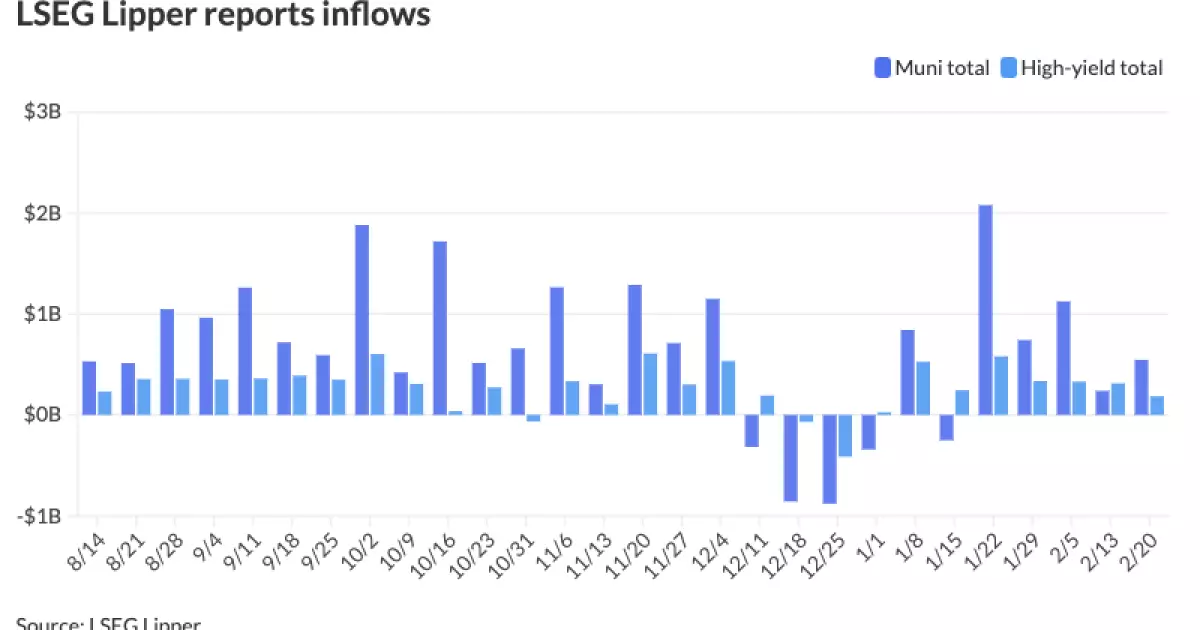The municipal bond market serves as a critical component of the global financial ecosystem, offering a refuge for investors seeking lower-risk assets compared to equities and other investment vehicles. In recent days, we have witnessed the stabilization of municipal bond prices in the wake of a significant issuance tied to the Brightline West Passenger Rail Project, revealing the underlying dynamics and forces at play in this sector.
The Brightline West Passenger Rail Project has successfully secured a fresh influx of capital, pricing $2.5 billion worth of green revenue bonds. This endeavor not only highlights the growing trend of green financing but also illustrates investor sentiment towards projects aimed at sustainability. Observations from recent market activity indicate that municipal bonds have remained steady and even slightly firmer following this significant deal. The introduction of such large-scale projects serves two purposes: it satiates the appetite for investments with positive environmental impacts, and it helps facilitate much-needed infrastructure improvements that can bolster local economies.
These positive sentiments are further reflected in the behavior of U.S. Treasury yields, which have dipped slightly. Investors in municipal bonds may find added comfort in equities declining, as this trend often leads to a shift in preference toward safer, income-producing assets like municipal bonds. The competitive edge that municipal bonds offer, particularly in tax-exempt forms, remains appealing, especially in periods of economic uncertainty.
Examining the municipal-to-U.S. Treasury (UST) yield ratios reveals interesting insights into the bond market’s current state. Ratios this Thursday show notable positions: 62% for the two-year, 63% for five-year bonds, 67% in the ten-year category, and 85% in the thirty-year segment. These numbers tell us that municipal bonds are relatively attractive compared to taxable forms, suggesting that investors are finding value amidst the offerings, particularly in the longer-dated bonds.
Moreover, as articulated by James Pruskowski of 16Rock Asset Management, the sustained lower rates experienced in January and February have set the stage for a more stable environment for municipal bonds. With markets increasingly adjusting to macroeconomic narratives, the anticipation for volatility persists, making timing crucial for investors. As liquidity in the market ebbs and flows, robust reinvestment capital coupled with light supply has strategically positioned the tax-exempt market well.
Looking forward, industry experts indicate that continued fund inflows are likely while UST rates remain range-bound or trend downward. This trajectory not only provides short-term stability but also enhances the attractiveness of municipal bonds in the context of long-term projections that favor decreased interest rates by 2025.
In the primary market, several key transactions have occurred that underscore the health and vigor of municipal financing. Highlighting some noteworthy entries, Morgan Stanley’s pricing of non-rated green revenue bonds for the Brightline West Project exemplifies the shift toward socially responsible investing. Additionally, Miami-Dade County and the Wisconsin Health and Educational Facilities Authority made significant issuances that appeal to a diverse range of investors.
The competitive yields on these bonds, particularly those issued for long-term projects, have been compelling. For example, Miami-Dade’s airport revenue bonds reflect well-structured financing with yields that are aligned with investor expectations. Bonds that offer slightly higher yields tend to attract more interest, particularly when they are associated with infrastructural projects that promise future economic benefits.
Despite the positive outlook and robust issuance pipeline, challenges remain, particularly as we anticipate the usual seasonal dips in the market. According to J.P. Morgan strategists, the acceleration of supply in the coming months may create opportunities for investors seeking to capitalize at potentially lower price levels. This scenario is expected to demand a strategic approach to investing in municipal bonds, necessitating careful consideration of timing and market conditions.
Additionally, the changing composition of municipal supply may present sourcing challenges. As lower-rated bonds compete with established ones, investors will need to maintain diligence in evaluating credit quality alongside yield potential. Balancing risk and return will become paramount as the municipal market navigates through fluctuations expected leading into March and May.
Going forward, investors should remain vigilant and well-informed about the nuances of the municipal bond market. The emergence of supportive technicals, combined with the current landscape of rising yields at near one-year highs, provides opportunities for reinvesting capital intelligently. As market conditions evolve, understanding the dynamics of demand, supply, and macroeconomic factors will assist investors in making educated, timely investment decisions.
While the municipal bond market maintains a level of stability and opportunity through recent economic challenges, an analytical approach remains critical. Engaging with the intricacies of this sector can yield significant advantages for investors willing to adapt to changing conditions and capitalize on emerging opportunities.

